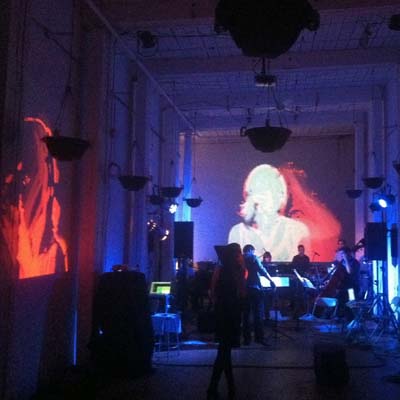|
P R E S S THEATER SCENE THE SOUND PROJECTOR CHICAGO READER NEW YORK CLASSICAL REVIEW VITAL WEEKLY PARIS TRANSATLANTIC NY MUSIC DAILY THE BIG CITY THE BIG CITY CHARLESTON CITY PAPER |
 |
|
ENSEMBLE PAMPLEMOUSSE EXPLORES A MONSTER'S LIFE Last night at Issue Project Room Ensemble Pamplemousse performed Uncanny Valley, an electroacoustic narrative suite with music by five [composers]: Jessie Marino, Andrew Greenwald, Dave Broome, Bryan Jacobs and Natacha Diels. The diversity of the suite’s four parts undoubtedly stems from having multiple composers involved, although the final two segments came together seamlessly despite a seismic thematic shift. The live ensemble onstage included Kiku Enomoto on violin, [Stankova] on vocals, Broome shifting between piano and melodica plus Andrew Roitstein on bass, Michael Caterisano and Matt Donello on percussion, with Ted Hearne (composer of the extraordinary Katrina Ballads) somewhat blissfully seizing the opportunity to conduct the group. This wasn’t tuneful music – other than the herky-jerky vocals in [Stankova]’s introductory segment, which followed octave-sized leaps (don’t herky-jerky vocals always do that?), melody didn’t enter into this much if at all until the end. There was definitely an improvisatory angle, especially with the piano’s occasional bursts of free jazz atonality. Despite the absence of much if any traditional cohesive melodicism, the suite was entertaining, and obviously put together (whether prior to the concert or during) with considerable thought. It follows the story of a golem, one that’s eventually killed for entering “the region where robotic human replicas begin to emulate human characteristics too closely, causing revulsion in observers.” Except that the music seemed to follow the opposite trajectory, from human to mechanical and then rather stunningly back again. After all, there’s something indelibly human about fingersnaps: there’s no machine mathematically capable of doing them as erratically as the group onstage, or any other group of people could have done, to introduce the suite. It took awhile to get going – Pamplemousse’s M.O. seems to be to build from the most elemental materials, as simply as possible – but after awhile the fun was contagious and just kept going from there. Marino’s intro built to an intricately, animatedly agile, rhythmic call-and-response replete with bursts of good humor, following an upward trajectory into Greenwald’s segment, where the poor beast is set loose in the world. Maybe because one of the composers (Diels) is a flutist, there was an overwhelming emphasis on higher frequencies – squeaks, clicks, creaks, peeps, the occasional swooping phrase or cry. As the piece went on, there was a gradual shift from treble, to a balance of lows and highs, to a sudden shift from staccato to sostenuto, and with that, to the lower registers. The effect of the strings’ sudden, insistent, judiciously interwoven tectonic shifts was richly rewarding, a fitting way for Jacobs to memorialize the poor monster. There was also a multimedia element, which got lost. Maybe this was deliberate; maybe it was a function of sonic capabilities or lack thereof. It seemed a little incongruous to have a machine as part of the golem: was this particular golem humanoid? From what was being played back off the laptop, vocals included, it was as if it had a life, or an imitation of one, that was completely separate from what the musicians were playing. And while the visual component wasn’t unpleasant, it didn’t add anything – which simply affirms how entertaining, and suspenseful, the music was. Ensemble Pamplemousse’s next multi-composer concert is December 17 at 8 PM at the AC Institute, 547 W 27th St, 6th floor. New York Music Review, Nov 10 2011 |